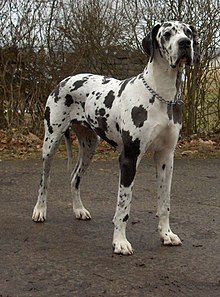Great Dane
| Great Dane | |||||||||
|---|---|---|---|---|---|---|---|---|---|
 A Harlequin Great Dane | |||||||||
| Other names | Grand Danois (18th Cent. French: 'Great Dane' the modern French is Dogue Allemand ("German Mastiff"). Deutsche Dogge ('German Mastiff') | ||||||||
| Common nicknames | Dane Gentle Giant | ||||||||
| Origin | Denmark/Germany | ||||||||
| |||||||||
| Dog (domestic dog) | |||||||||
The Great Dane (18th Cent. French: Grand Danois), also known as German Mastiff (German: Deutsche Dogge) or Danish Hound (German: Dänischer Hund), is a breed of domestic dog (Canis lupus familiaris) known for its giant size.[2] The Great Dane is one of the world's tallest dog breeds; the current world record holder, measuring 109 cm (43 in) from paw to shoulder; 220 cm (7.2 ft) from head to tail, is George.[3]
Description
Appearance

As described by the American Kennel Club, "The Great Dane combines, in its regal appearance, dignity, strength and elegance with great size and a powerful, well-formed, smoothly muscled body. It is one of the giant working breeds, but is unique in that its general conformation must be so well balanced that it never appears clumsy, and shall move with a long reach and powerful drive."[4] The Great Dane is a short haired breed with a strong galloping figure.[5] In the ratio between length and height, the Great Dane should be square. The male dog should not be less than 30 in (76 cm) at the shoulders, a female 28 in (71 cm). Danes under minimum height are disqualified.[4]
From year to year, the tallest living dog is typically a Great Dane. Previous record holders include Gibson and Titan, however the current record holder is a blue Great Dane named Giant George who stands 43 in (110 cm) at the shoulder.[6] He is also the tallest dog on record (according Guinness World Records),[6] beating the previous holder who was a brindle Great Dane named Shamgret Danzas, who stood 42.5 in (108 cm) at the shoulder.
The minimum weight for a Great Dane over eighteen months is 120 lb (54 kg) for males, 100 lb (45 kg) for females.[5][7] Unusually, the American Kennel Club dropped the minimum weight requirement from its standard.[8] The male should appear more massive throughout than the female, with a larger frame and heavier bone.[4]
Great Danes have naturally floppy, triangular ears. In the past, when Great Danes were commonly used to hunt boars, cropping of the ears was performed to make injuries to the dogs' ears less likely during hunts. Now that Danes are primarily companion animals, cropping is sometimes still done for traditional and cosmetic reasons. Today, the practice is somewhat common in the United States and much less common in Europe. In some European countries such as the United Kingdom, Ireland, Denmark, Germany, parts of Australia, and in New Zealand, the practice is banned, or controlled to only be performed by veterinary surgeons.
THe great dane is pretty and it is the same dog as
-
Caption1
-
Caption2
Scooby Doo
Temperament
The Great Dane's large and imposing appearance belies its friendly nature; the breed is often referred to as a gentle giant.[4] Great Danes are generally well-disposed toward other dogs, other non-canine pets and humans, although, when feeling threatened, have been known to attack humans. This is usually brought on by a person that is unfamiliar to the dog. Some breeds may chase or attack small animals, but this is not typical with Great Danes.[9] The great dane is a very gentle and loving animal with proper care and training. They are also very needy, always needing someone. Some may find them frightening because of their huge structure and loud bark, but they have no intention of harming people.
Exercise
Like most dogs, Great Danes require daily walks to remain healthy. However it is important not to over exercise this breed, particularly when young. Great Dane puppies grow very large, very fast, which puts them at risk of joint and bone problems. Because of a puppy's natural energy, Dane owners often take steps to minimize activity while the dog is still growing.[10][11]
Given their large size, Great Danes continue to grow (mostly gaining weight) longer than most dogs. Even at one year of age a Great Dane will continue to grow for several more months.[12]

Health
Great Danes, like most giant dogs, have a fairly slow metabolism. This results in less energy and less food consumption per pound of dog than in small breeds. Great Danes have some health problems that are common to large breeds, including gastric dilatation-volvulus (GDV) (a painful distending and twisting of the stomach). This is a critical condition that can affect Great Danes and other deep-chested breeds, and which may cause death if not quickly addressed. Drinking large amounts of fluid in a short period of time can provoke GDV in Great Danes, as well as other larger breeds of dogs. It is a commonly recommended practice for Great Danes to have their stomachs tacked (Gastropexy) to the right abdominal wall if the dog or its relatives have a history of GDV, though some veterinary surgeons will not do the operation if the actual sickness has not occurred. Elevated food dishes are often believed to help prevent GDV by regulating the amount of air that is inhaled while eating, although one study suggests that they may increase the risk.[13] Refraining from exercise or activity immediately before and after meals may also reduce risk, although this has not been validated with research. Signs that GDV may have occurred include, but are not limited to, visible distension (enlargement of the abdomen) and repeated retching that resembles repetitive non-productive attempts to vomit. GDV is a condition that is distinct from another condition referred to as bloat; though, bloat may precede the development of GDV. GDV is a surgical emergency; immediate veterinary evaluation should be sought if a dog demonstrates signs of this condition.
Breed clubs health surveys in the UK and US put the average life span of Great Danes at 6.5 to 7 years.[14][15]
Dilated cardiomyopathy (DCM) and many congenital heart diseases are also commonly found in the Great Dane, leading to its nickname of the Heartbreak breed, in conjunction with its shorter lifespan. Great Danes also suffer from several genetic disorders that are specific to the breed. For example, if a Great Dane lacks color (is white) near its eyes or ears then that organ does not develop and usually the dog will be either blind, deaf, or both.[16]
History
According to Barbara Stein, "The breed originated in Germany, probably from a cross between the English mastiff and the Irish Wolfhound."[17] However, other sources maintain that the breed originated in Denmark[unreliable source?][18] and still others report the question as controversial and unsettled.[19] In 1749 Georges-Louis Leclerc, Comte de Buffon[20] used the name "le Grand Danois," (translated by William Smellie as "Great Dane"). Up until that time the hound was referred to in England as "Danish dog."[21] According to Jacob Nicolay Wilse the Danes called the dog "large hound," a terminology continued well in to the 20th century.[22] As late as in the 1780 Germany the hound is referred to as "Grosser Dänischer Jagdhund" (English: Large Danish Hunting Hound).[23] At the first dog exhibition, held in Hamburg 14–20 July 1863, eight dogs were called "Dänische Dogge" and seven "Ulmer Doggen."[24]

Great Danes in popular culture
- The Great Dane was named the state dog of Pennsylvania in 1965.[25]
- Scooby-Doo, the famous Hanna-Barbera character, was based on a Great Dane by animation designer Iwao Takamoto. Takamoto based his illustrations on sketches given to him by a Hanna-Barbera employee who bred this dog. Scooby closely resembles a Great Dane, although his tail is longer than the breed's, bearing closer resemblance to a cat's tail.[26][27]
- The athletic teams of the University at Albany have been known as the Great Danes since 1965. Damien The Great Dane has been the mascot since that time. In 2003, the school added Lil' D, a smaller Great Dane, to help Damien entertain the crowds.
- Brutus in The Ugly Dachshund, a Great Dane raised by a Dachshund mother.
- Marmaduke is a newspaper comic strip drawn by Brad Anderson from 1954 to the present day. The strip revolves around the Winslow family and their Great Dane, Marmaduke.
- Singer, the main but tragic hero of The Guardian, a novel by Nicholas Sparks.
- Elmer, a Great Dane in Oswald the Lucky Rabbit by Walter Lantz
- In each film version of Sir Arthur Conan Doyle's "The Hound of the Baskervilles", a Great Dane was cast as the cursed hellhound that kills the Baskerville family.
- Astro from The Jetsons is a gray Great Dane.
See also
References
- ^ "Es war ein reizender Abend," short story by Erich Kästner.
- ^ Becker,The Great Dane - Embodying a Full Exposition of the History, Breeding Principles, Education, and Present State of the Breed (a Vintage Dog Books Breed Classic): Embodying a Full Exposition the History, Breeding Principles, Education, and Present State of the Breed, Published by READ BOOKS, 2005, ISBN 1-905124-43-0.
- ^ Jones, Sam (22 February 2010) Giant George takes crown as the world's tallest dog, The Guardian
- ^ a b c d Cite error: The named reference
AKCwas invoked but never defined (see the help page). - ^ a b "UK Kennel Club Breed Standard"
- ^ a b "Guinness: Arizona Great Dane is tallest dog ever". Washington Post. 22 February 2010. Retrieved 23 February 2010. [dead link]
- ^ "New Zealand Kennel Club standard"
- ^ Cunliffe, Juliette (2005). The Complete Encyclopedia of Dog Breeds. UK: Parragon Publishing. ISBN 1-40544-389-8.
- ^ Great Dane: A Comprehensive Guide to Owning and Caring for Your Dog, Kennel Club Book, 2003, ISBN 1-59378-273-X
- ^ "The Great Dane Adoption Society, Care Advice"
- ^ "All about Great Danes.com Exercise advice"
- ^ [1]
- ^ Journal of the American Veterinary Medical Association, Non-dietary risk factors for gastric dilatation-volvulus in large and giant breed dogs
- ^ "Summary results of the Purebred Dog Health Survey for Great Danes" (PDF). Kennel Club/British Small Animal Veterinary Association Scientific Committee. 2004. Retrieved 29 March 2010.
- ^ "National Health Survey" (PDF). Great Dane Club of America. 2004. Retrieved 29 March 2010.
- ^ "Great Dane rescue a labor of love", by Tamara Phillips, March 23, 2008, Daytona Beach News-Journal.
- ^ Collier's Encyclopedia, 1993, sv Great Dane
- ^ "The Great Dane – A Danish Cultural Heritage." Great Danes: House of Apollon.
- ^ animal-world.com/
- ^ "Histoire Naturelle, générale et particulière"
- ^ "Canine Madness", 1762).
- ^ "Fuldstændig beskrivelse af stapelstaden Fridericia – efter pålidelige underretninger og egne undersøgninger." 1767, p176
- ^ Edward C. Ash : Practical Dog Book, 1931, "The Great Dane"
- ^ Bulletin Officiel de la Société Canine de Monaco, August 1938
- ^ State Symbols USA, www.statesymbolsusa.org
- ^ "Iwao Takamoto, 81, the Animation Artist Who Created Scooby-Doo, Dies", by Susan Stewart, January 10, 2007, The New York Times
- ^ "Iwao Takamoto, cartoonist who created Scooby-Doo, dies at 81", The Associated Press, January 9, 2007, Canadian Broadcasting Corporation

